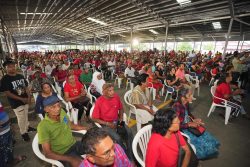Introduction
I must begin this week with an apology to my readers. When I reviewed the 2006 annual report of J.P Santos & Co Ltd (JPS) I spotted an inter-group disposal of assets which I believed should be treated as a one-off and adjusted the earnings per share accordingly. In fact, standard accounting practice is to eliminate all inter-group transactions on consolidation: the financial statements should not have included the gain in the first place. Shortly after my analysis was published an updated set of accounts with a revised audit opinion was issued; these showed earnings per share of 4.50 compared with my adjusted figure of 4.83 – the difference being attributable to the capital gains tax which I also backed out as I assumed it would not recur, (on consolidation the group is still liable to the tax on the disposal so this item is not backed out on consolidation). The difference in these two figures drives home my point that the inter-group transfer of assets appeared to be tax-inefficient, the tax charge amounted to 0.33 per share.
As was the case last year, the information disclosed in the financial statements published in the press goes well beyond the requirements of the Securities Industry (Disclosure by Reporting Issuers) Regulations 2002. In particular, a consolidated statement of cash flows is included. The consolidated statements include the results for the Company as well as the Company’s 51% stake in Bryden & Fernandes and the 100% stake of the recently formed subsidiary JPS Trading Inc.
Positive Outlook
In Guyana, most Chairmen’s statements tend to paint a neutral (if not negative) outlook. The few positive words are often qualified. The JPS interim report thus makes refreshing reading, the Chairman, Mr Christopher Fernandes reports “The Directors are optimistic the Group will continue to show an improved performance during the second half of the year which will result in a favourable overall performance for 2007 as compared to 2006. The group continues its expansion plans begun in 2006 with the commencement of a new Meat Centre at Grove, East Bank Demerara”. Mr Fernandes reports “It is hoped this facility would be completed by November 30, 1997 and will provide an enhanced shopping facility for residents in the growing Grove and Diamond residential areas.”
I think this is a sound decision taken by the group; indeed the Diamond housing scheme is growing and provided it can be completed on time the meat centre will no doubt benefit from the increase in demand around Christmas time. I would have liked to have seen some information of how the meat centre will be financed: the Group is being financed in no small part by its overdraft facilities, and the rate tends to be higher than on longer term loans (as of the end of the year the interest rates on the overdraft and its long term loan facility were 12% and 10% respectively).
Financial
Performance
For the second six- month period running Group turnover has exceeded G$1 billion in the period to 30 June 2007. However for the first time since interim reporting began revenue fell compared with the previous six-month period. Some care is needed in interpreting this fall in revenue though: compared with the equivalent period one year ago revenue increased 5% and trailing twelve-month revenue increased 2.5%. Historically 53.4% of the Group’s revenue has been earned in the second half of the year, allowing for this seasonal adjustment six-month revenue has barely dipped. Gross profit margins (gross profit over revenue) have remained stable at 17% thus the increase in revenue has seen profit from operations increase by a similar amount; up to G$54.7m from G$51.3m for the six-month period a year earlier. The 27% increase in profit after tax has thus largely been driven by a 62% increase in other income: we must await the annual report to discover whether this income is likely to be a recurring item of income. (See Chart 1 & 2)
Conclusions
JPS has seen group profit increase substantially compared with a year ago. Trailing twelve- month earnings now stand at an all time high of 5.07 dollars per share. The second half of the year will reveal whether the dip in revenue is indeed due to seasonal effects or whether the growth in performance of the group is finally slowing after a substantial upwards innings. I think the former is more likely than the latter given the historical penchant for timing expansions so as to continue to grow revenues. (See Chart 3)
This writer has an interest in JPS by virtue of the writer and/or an associate being a shareholder.









